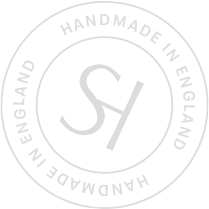We met designer, Phoebe English, to discuss sustainability, our partnership and how she is educating the UK fashion industry to be better.
Sustainability is something that underpins everything we do; from keeping our waste to a minimum by making gowns to order, to recycling and reusing our by-products. One of the ways in which we’ve been recycling our offcuts, has been to partner with like-minded brands and businesses. Phoebe English is a British fashion designer committed to changing and educating the way the UK fashion industry impacts the environment. Her brand only uses dead stock or waste textiles to create their collections, and we’ve been delighted to send Phoebe and her team our silk and lace offcuts, to turn into garments for her latest collections. We wanted to know more about Phoebe, so we sat down with her to find out how she became interested in fashion and it’s impact on our planet.
Have you always been interested in fashion and design, and was it always your goal to have your own brand?
I come from a family with strong artistic sensibilities, but applying this to clothing has a much more practical element and was something I was interested in and inspired by from a very young age. Some of my earliest memories include lots of details about specific garments and having a fashion label was something that happened to me rather than being something that I had planned out.
Why is sustainability and circular fashion so important not only to you personally, but for the fashion industry in general?
It’s something that is integral for the future of our planet. The fashion industry is one of the most polluting and damaging industries, as a worldwide sector, it is absolutely vast and is a massive contributor to both climate change and worldwide destruction of biodiversity. We need to disinherit our damaging fashion practices and value systems and learn to create new ones. I think the most important thing is education, so that the new generation of design talent can be empowered to move forward in a more positive and transactional way.
What gave you the idea to reach out to bridal designers for offcuts; it’s such a fantastic idea! Have you found that most brands have been happy to help?
As a studio, we constantly work towards solution-based design practices and how we can create a less negative impact and hopefully, eventually, even create a positive impact. With the U.K. textile and fashion industry, unfortunately, there is little to no recycling of waste streams that avoid landfill available to us as businesses, so we are forced to throw away our textile leftovers. It’s something that we have struggled with over the years and eventually, we got so frustrated that we wanted to work with other companies to create solutions for their waste textiles too, whilst hopefully creating a beautiful end garment. We view these offcuts as a precious textile resource and are really happy to work with them. We contact different brands and companies to see if we can partner with them they aren’t always able to be involved but when you do find one it becomes a really special relationship as most people are keen to see their scraps reused into something new. It’s a really satisfying way to work. With the bridal companies we had been looking for a light coloured fabric we could trial our natural dye research on, as bridal fabric are majority white and cream it seemed like a good area to start looking at, we have been so pleased with the reception and the outcomes and have made some fantastic partnerships such as the one we have with you.
What is your process for upcycling? Do you design your pieces once you’ve seen the offcut material, or do you make the material work for you?
We often now start the design process in the reverse way that we did previously. First of all, we see what material we have, or acquire, or what solution we can provide. So, for instance, with the lace, we identified the problem of bridal dress offcuts and then started to think about what garments we could construct from them, how we could use these precious fabrics in an efficient and beautiful way (to minimise waste) and a way that creates something with an interesting surface design and ultimately a garment that people will also hopefully find desirable. So yes, the design process goes from fabric waste partner research to fabric waste sourcing, to sorting scraps, to editing the scraps, then to trialling Textile construction ideas and then eventually into a garment shape and design. So the garment design comes in right at the end of the process rather than at the start of we were to start with a sketch as to how we previously worked.
What have been the challenges (if any) with trying to keep your carbon footprint small from sketch to final garment?
There are so many challenges every day; with every detail, we consider our carbon footprint and fibre miles, whether that is our biodegradable entirely paper packaging, a studio ban on brand new fabrics or sourcing of dead stock or scrap fabric, or our garment labelling. Everything we do is underpinned by research and development into solutions focused on sustainability, and we are learning every day and a lot of these things because you are setting them up from scratch each time can be hit or miss and take months and months of preparation so can be much much more time demanding. We still have so much to learn and try out.
What advice could you give to other fashion brands who want to become more sustainable and minimise their negative effect on the planet?
Considering the impact of each of your design decisions is a good place to start, each decision we make as designers has a knock-on effect somewhere along the supply chain and learning where these can be and what to try and avoid is a good start. In the beginning, we did lots of things like online courses, watching documentaries, attending panel talks and seminars and mainly asking people for advice and help so we could learn. Thinking about the life of the garment beyond your own interactions with it is also helpful, how long will the life cycle of this garment be, for example, can it be repaired or reused etc and what happens to it at the end of its lifecycle, is it possible for it to biodegrade or will it end up in a landfill? Where were the components sourced from and how far has it had to travel? There are so many elements to consider and it can often feel really overwhelming and too big to tackle, at the start we only concentrated on one element at a time which really helped, we started by simply just replacing one plastic bag for one paper bag and the rest fell in place after that.
What has been your proudest moment for you or (the brand) since launching ?
I think most recently, it was being awarded a Changemakers award under the category of Environment at the Fashion Awards last month. It is so wonderful as such a small studio and team to be recognised alongside larger brands and amongst such an incredible host of nominees too. There have been many steps along the way, but this feels like quite a milestone and especially owing to how difficult the pandemic hit us as a small business.
Finally, what changes would you like to see in the fashion industry in general to ensure brands tackle the impact that the business create on contributing to climate change?
I think brands considering the life cycle of their garments more would be really impactful and also thinking carefully about the regularity, quantity and scale we are producing at. Does the world really need the number of clothes we produce as a whole industry for example? Is that in alignment with the realities of what’s happening to where we all live? Keeping mindful of the bigger picture is really key. And most importantly we need to work together and support each other in the fashion industry to create positive change. There has already been such a big shift in recent years, I really hope that this continues.
Photography © Asia Werbel
To learn more about Phoebe English visit her website or Instagram.








